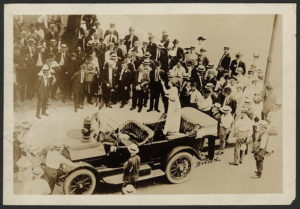by Jack El-Hai, Wonders & Marvels contributor
“Only four of us here and not a thing to do but keep awake,” a St. Paul, Minn., policeman complained in July 1916, during the national convention of the nation’s oldest third party. “This sure is the most orderly bunch I ever saw.”
There were no smoke-filled rooms, no delegates carousing late at night. These conventioneers, gathering to nominate their party’s candidate for president of the United States, were neither Republicans nor Democrats. They represented the Prohibition Party, and they aimed to abolish the sale and consumption of liquor in America.
Founded in 1869 in Chicago, the Prohibition Party had fielded candidates in eleven presidential elections before 1916. The most successful, John Bidwell, collected 263,000 votes in 1892. But the party had never come close to placing a nominee in the White House or even carrying a state.
Party members viewed the 1916 convention as especially important. Prohibition already existed in many states, and a nationwide liquor ban seemed inevitable. With its main goal nearly achieved, the party faced the possibility of extinction.
The national committee scheduled its 1916 convention for July 19-21 in St. Paul, the furthest west the party had ever gathered. Its leaders held no illusions of outpolling the Republicans or Democrats in the election, but they hoped to snatch third place away from the Socialists and tally 1 million votes — four times as many as they had ever received.
Meanwhile, the local Prohibition Party committee procured for visiting delegates 7,200 bottles of drink—nonalcoholic grape juice, of course.
On July 18 trains in the St. Paul depot began disgorging the 658 delegates and 19 alternates — a peculiar assortment of men and women from 47 states, with the largest contingent from California. Among them were Charles Randall of California, the only Prohibition party congressman; the Rev. L.G. Jordan, a former slave on the plantation of Confederate president Jefferson Davis; a reformed criminal from New York known only as Convict 11.221; and Dr. A.D. Bridgman of Illinois, who attended all convention functions wearing a long black frock coat and silk top hat: “I declaim that it is proper convention regalia,” he said.
The following day, the convention delegates got down to the business of picking a presidential candidate. They chose J. Frank Hanly of Indiana on the first ballot. Placed in nomination for vice-president was Marie C. Brehm, a prominent Women’s Christian Temperance Union activist from Chicago — the first woman ever nominated for the ticket of a national political party. But Ira Landrith, a veteran prohibitionist from Tennessee, won final approval as Hanly’s running mate.
The convention disbanded and the delegates left St. Paul with high hopes of reaching 1 million votes and carrying one or two states. Prohibition sentiment was high, the party had taken strong stands on other issues, and its candidates were on the ballot in 44 states. How could they miss?
They missed. The Hanly-Landrith ticket received only 220,000 votes, barely 1 percent of the total. It was no surprise that Woodrow Wilson trounced them, but quite a humiliation that A.L. Benson, the Socialist candidate, out-polled them three to one.
On the national scene, the Prohibition Party never recovered from the campaign that began with its St. Paul convention. Its influence dimmed once Prohibition won ratification in 1919 and remained low after laws banning alcohol sales were repealed in the 1930s. The Party’s 2012 candidate for U.S. President received only 518 votes, and its 2016 candidate, Jim Hedges of Pennsylvania, won the Party’s nomination not at a convention, but by conference call.
Further reading:
Koerner, Brendan. “What Do They Serve at a Prohibition Party?” U.S. News and World Report, July 12, 1999, Vol. 127(2), p. 51.
Storms, Roger. Partisan Prophets: A History of the Prohibition Party, 1854-1972.

